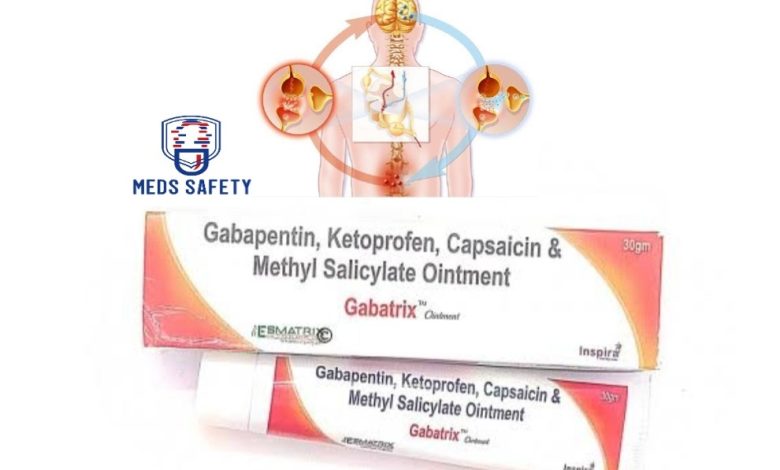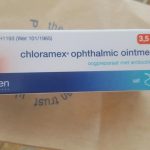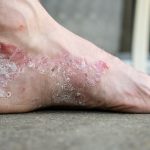Gabatrix Ointment: Uses, Benefits, Dosage, Side Effects, Interactions

Gabatrix Ointment is a combined medication designed to alleviate neuropathic pain. It effectively treats persistent pain resulting from nerve damage associated with conditions like diabetes, shingles, and spinal cord injuries. Neuropathic pain arises from disorders affecting the nervous system, which occur due to chronic progressive nerve diseases, infections, or injuries. Neuropathic pain is a relatively common condition. It is estimated that approximately 7-10% of the general population worldwide experiences neuropathic pain at some point in their lives. The prevalence of neuropathic pain may vary depending on the specific population and underlying causes.
Certain conditions are commonly associated with neuropathic pain, such as diabetic neuropathy, postherpetic neuralgia (resulting from shingles), and peripheral neuropathy. These conditions contribute to a significant proportion of neuropathic pain cases.
The composition of Gabatrix Ointment 30 gm includes four active ingredients: Capsaicin, Gabapentin, Ketoprofen, and Methyl salicylate. Capsaicin, derived naturally from chili pepper, functions by obstructing pain signals to the nerves. Gabapentin, an anti-epileptic agent, modifies the transmission of nerve messages to the brain, thereby providing pain relief. Ketoprofen, a non-steroidal anti-inflammatory drug (NSAID), acts by inhibiting the release of specific chemical substances, such as prostaglandins and leukotrienes, known to induce pain and inflammation. Methyl salicylate, a topical rubefacient, temporarily alleviates muscle or joint pain arising from strains and sprains.
By combining the therapeutic properties of Capsaicin, Gabapentin, Ketoprofen, and Methyl salicylate, Gabatrix Ointment offers comprehensive relief from neuropathic pain due to nerve damage and other neurological disorders.
How to use Gabatrix Ointment
Gabatrix Ointment 30 gm is intended exclusively for external use. Dispense a small amount, approximately the size of a pea, onto your fingertips and gently apply it to the affected areas. It is important to follow your doctor’s prescribed duration of use, which will depend on your specific medical condition.
When using Gabatrix ointment, it is important to exercise caution and follow certain guidelines:
1. Avoid contact with eyes, nose, mouth, and other mucous membranes: Gabatrix can cause irritation and discomfort if it comes into contact with sensitive areas. Take care to prevent accidental contact and wash your hands thoroughly after applying the ointment.
2. Do not apply to broken or irritated skin: Using Gabatrix ointment on open wounds, cuts, or irritated skin can lead to further irritation and potential absorption of the medication into the bloodstream. Apply only to intact skin surfaces as directed by your healthcare provider.
3. Start with a small amount: Begin with a small application of Gabatrix ointment to a small area of skin to test for any adverse reactions or excessive irritation. If well-tolerated, you can gradually increase the amount and area of application as instructed.
4. Avoid heat sources or excessive heat exposure: Gabatrix can increase the sensation of heat or burning when applied to the skin. To minimize discomfort, avoid exposure to excessive heat sources such as hot showers, saunas, heating pads, or direct sunlight immediately after applying the ointment.
5. Follow the recommended usage frequency: Adhere to the prescribed frequency of application provided by your healthcare professional. Using more than the recommended amount or frequency may lead to heightened irritation or side effects.
6. Consult your doctor for interactions and contraindications: Inform your healthcare provider about any other medications, topical treatments, or medical conditions you have to ensure there are no potential interactions or contraindications with Gabatrix ointment.
Always consult with your healthcare provider or read the product instructions for specific cautions and recommendations regarding using Gabatrix ointment.
Who should not use Gabatrix ointment?
Please refrain from using Gabatrix Ointment under the following circumstances:
1. Recent heart surgery: If you have undergone heart surgery recently, Gabatrix Ointment should not be used. This medication can heighten the risk of a potentially fatal heart attack or stroke.
2. Increased risk of stomach ulcers and bleeding: Gabatrix Ointment may elevate the likelihood of developing stomach ulcers and experiencing bleeding. Therefore, if you are susceptible to such conditions, it is advisable to avoid using this ointment.
3. Pregnancy and breastfeeding: Unless prescribed by a healthcare professional, pregnant or breastfeeding individuals should not use Gabatrix Ointment. It is essential to consult with your doctor regarding the potential risks and benefits associated with this medication during these periods.
4. Not recommended for children: Gabatrix Ointment is not recommended for children due to the lack of established safety and efficacy data in this age group.
5. Sunlight exposure: To prevent a burning sensation, it is advisable to limit or avoid exposure to natural or artificial sunlight while using Gabatrix Ointment.
6. Avoid concurrent use of other NSAIDs: Unless specifically prescribed by a healthcare provider, refrain from taking any other non-steroidal anti-inflammatory drugs (NSAIDs) for pain relief alongside Gabatrix Ointment.
Gabatrix Ointment Side Effects
Some potential side effects of using Gabatrix Ointment may include:
1. Itching: A sensation on the skin that triggers the urge to scratch.
2. Irritation: Discomfort or inflammation of the skin that may cause redness, itching, or a burning sensation.
3. Redness: The skin may appear flushed, inflamed, or have a reddish hue.
4. Burning sensation: A feeling of heat or burning on the skin where the ointment is applied.
It’s important to note that these side effects may vary in severity and occurrence from person to person. If any of these side effects persist or worsen, it is advisable to seek medical attention. Additionally, individuals with known allergies or sensitivities to any of the ingredients in Gabatrix Ointment should exercise caution and consult with a healthcare professional before use.
Interactions
Gabatrix Ointment has the potential to interact with various medications. These include blood thinners such as anisindione, dicumarol, and warfarin, as well as painkillers like hydrocodone and acetaminophen. Additionally, interactions may occur with antidepressants such as duloxetine, escitalopram, and sertraline, muscle relaxants like cyclobenzaprine, anti-anxiety drugs including alprazolam, fits medicines such as pregabalin, antipsychotics like quetiapine, steroids including prednisone, antidepressants like lithium, anti-cancer drugs such as methotrexate, gout medicines like probenecid, and water pills.
It is important to note that these interactions may vary in severity and can lead to adverse effects. Therefore, it is crucial to consult with a healthcare professional or pharmacist before using Gabatrix Ointment alongside any of the mentioned medications. They can provide specific guidance and ensure the safe and effective use of these medications together.
Non-Medicinal Ways To Help You Cope With Neuropathic Pain
Coping with neuropathic pain can be challenging, but there are strategies that can help manage and alleviate the symptoms. Here are some approaches that may be beneficial:
1. Physical therapy: Engaging in physical therapy can help improve strength, flexibility, and overall function. Therapists can provide exercises and techniques tailored to your specific condition, which may help reduce pain and improve mobility.
2. Transcutaneous Electrical Nerve Stimulation (TENS): TENS involves using a device that delivers mild electrical currents to the affected area, which can help disrupt pain signals and provide temporary relief.
3. Relaxation techniques: Techniques such as deep breathing, meditation, and progressive muscle relaxation can help reduce stress and promote relaxation, which may indirectly alleviate neuropathic pain.
4. Heat and cold therapy: Applying heat or cold packs to the affected area may help reduce pain and inflammation. Experiment with both methods to see which works best for you.
5. Lifestyle adjustments: Making certain lifestyle modifications can have a positive impact on neuropathic pain. This may include maintaining a healthy diet, getting regular exercise, managing stress, and getting enough sleep.
6. Support groups and counseling: Connecting with others who experience neuropathic pain through support groups or counseling can provide emotional support, helpful tips, and a sense of community.
Remember to consult with a healthcare professional to develop a comprehensive pain management plan tailored to your specific needs. They can provide personalized guidance and monitor your progress.




